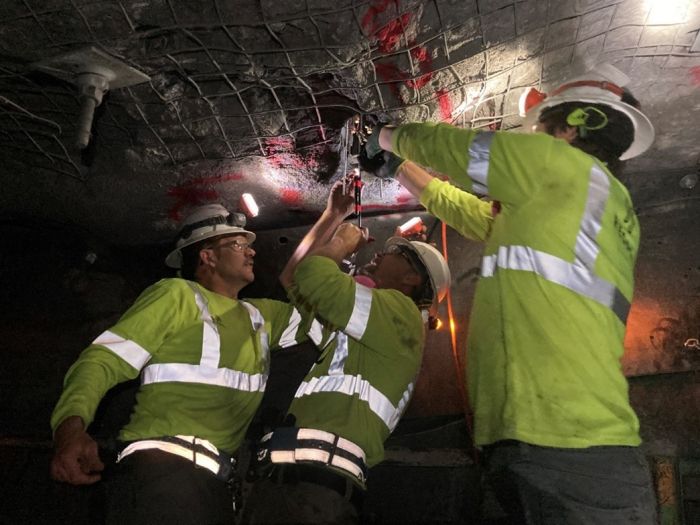






ホームステイク ニュートリノ実験は、ニュートリノ* 研究で 2002 年にノーベル物理学賞を共同受賞した物理学者レイ デイビスにちなんで「デイビス実験」とも呼ばれ、サウスダコタ州リードにある旧ホームステイク金鉱山で 1965 年から 1994 年まで実施されました。地下 1.48 km (4,850 フィート) (「4850 レベル」) では、科学者は宇宙放射線のほとんどを除去でき、星の中心核で発生したニュートリノだけを数えられると確信していました。
この鉱山は金価格の下落を受けて2001年に閉鎖されたが、その後サンフォード地下研究施設(SURF)に転換され、国際科学コミュニティが「宇宙的にクリーンな」環境で実験を行うことができるようになりました。フェルミ国立加速器研究所は、SURFの4850レベルに深部地下ニュートリノ実験(DUNE)用のニュートリノ検出器を建設しており、ホームステイクでのニュートリノ検出の伝統を継続しています。
必要な地下洞窟は非常に大きいため、RESPEC は建設中に掘削のリブとクラウンの異常な岩石の動きを検出する計測機器を設置する契約を結んだ。彼らは、洞窟のリブとクラウンに掘削された 10.2 cm (4 インチ) のボーリングホールに、長さ 10.1 ~ 19.8 m (33 ~ 65 フィート) の 4 点および 5 点のマルチポイント ボーリングホール伸縮計 (MPBX) を 64 個設置した。RESPEC は、個々の MPBX センサー アンカーが膨張している間、垂直および傾斜 MPBX を所定の位置に固定するためのカスタム拡張アンカーを開発しました。また、それぞれ 14 個の傾斜計で構成される 2 つの傾斜計ストリングも設置されました。
センサーからデータを読み取るために、Campbell Scientific CR6 および CR1000X 自動監視プラットフォーム 7 台、Campbell Scientific マルチプレクサ 14 台、および AVW200 バイブレーティングワイヤ インターフェイス モジュール数台が設置されました。CR6 および AVW200 デバイスは、Campbell Scientific の特許取得済み VSPECT ® バイブレーティングワイヤ技術を使用しています。
建設作業員が継続的に発破作業を行い、設備の近くで作業していたため、設置の設計とプロセスは複雑になり、センサーの設置タイミングを他の現場での作業と調整する必要がありました。すべての機器とセンサーのケーブルは、近くの発破による飛散岩から保護する必要がありました。
深部地下ニュートリノ実験は、科学者がニュートリノをより深く理解し、宇宙の謎の一部を解明するのに役立つかもしれません。さらに、この実験は物理学者が、なぜ私たちが物質優位の宇宙に住んでいるのかを理解するのに役立つかもしれません。
*ニュートリノは、原子核より小さな粒子です。ニュートリノは、宇宙で最も質量を持つ粒子ですが、他のものとほとんど相互作用しません。
ニュートリノ全般に関する詳しい情報については、次の Web ページをご覧ください。
ニュートリノの研究の詳細については、次の Web ページをご覧ください。